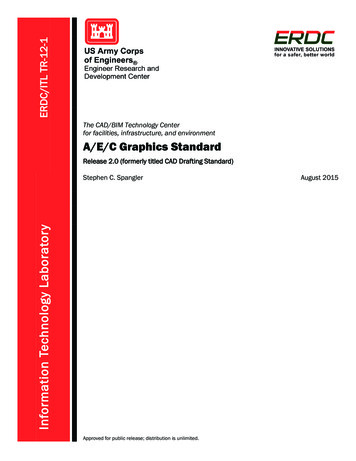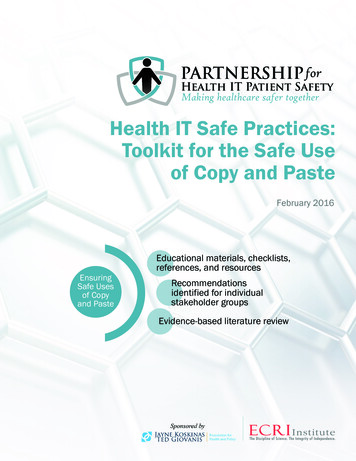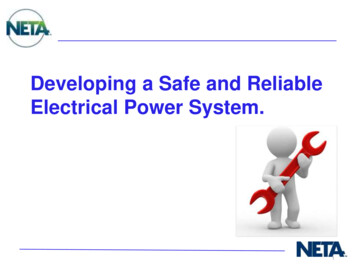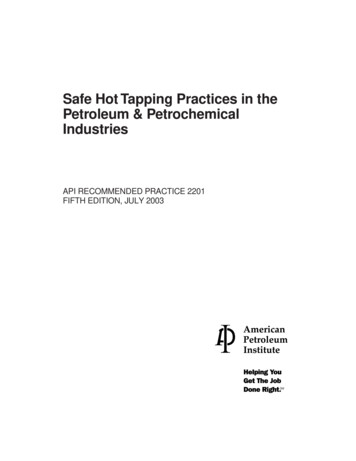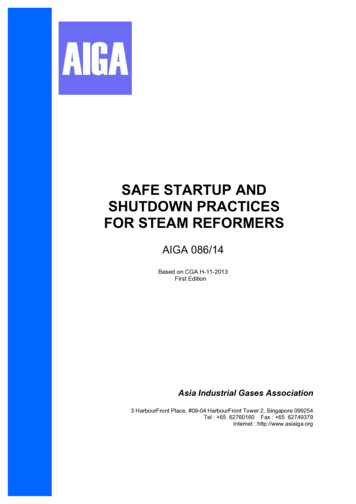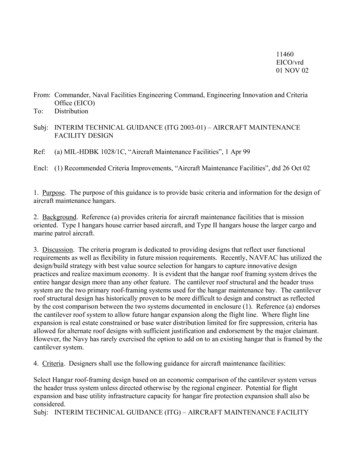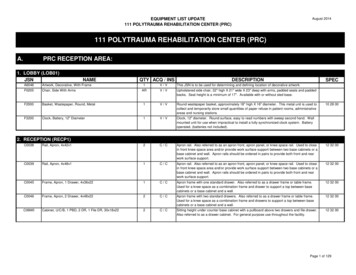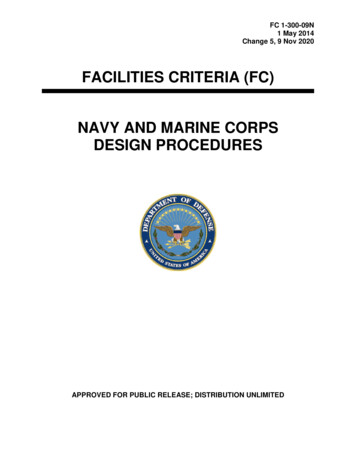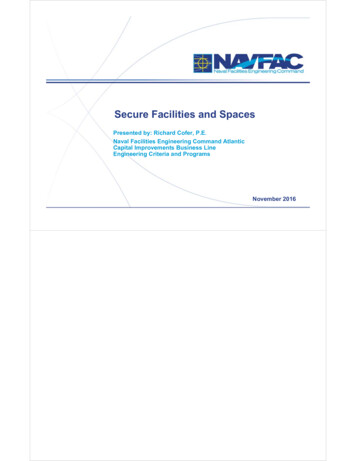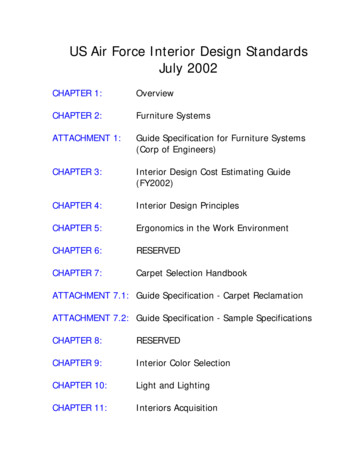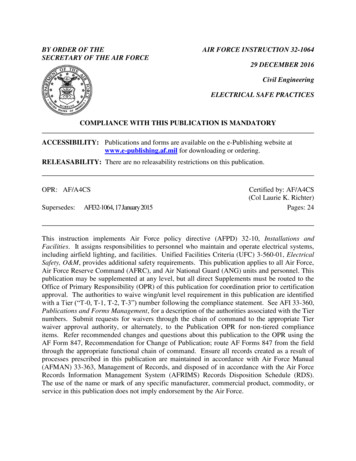
Transcription
BY ORDER OF THESECRETARY OF THE AIR FORCEAIR FORCE INSTRUCTION 32-106429 DECEMBER 2016Civil EngineeringELECTRICAL SAFE PRACTICESCOMPLIANCE WITH THIS PUBLICATION IS MANDATORYACCESSIBILITY: Publications and forms are available on the e-Publishing website atwww.e-publishing.af.mil for downloading or ordering.RELEASABILITY: There are no releasability restrictions on this publication.OPR: AF/A4CSSupersedes:AFI32-1064, 17 January 2015Certified by: AF/A4CS(Col Laurie K. Richter)Pages: 24This instruction implements Air Force policy directive (AFPD) 32-10, Installations andFacilities. It assigns responsibilities to personnel who maintain and operate electrical systems,including airfield lighting, and facilities. Unified Facilities Criteria (UFC) 3-560-01, ElectricalSafety, O&M, provides additional safety requirements. This publication applies to all Air Force,Air Force Reserve Command (AFRC), and Air National Guard (ANG) units and personnel. Thispublication may be supplemented at any level, but all direct Supplements must be routed to theOffice of Primary Responsibility (OPR) of this publication for coordination prior to certificationapproval. The authorities to waive wing/unit level requirement in this publication are identifiedwith a Tier (“T-0, T-1, T-2, T-3”) number following the compliance statement. See AFI 33-360,Publications and Forms Management, for a description of the authorities associated with the Tiernumbers. Submit requests for waivers through the chain of command to the appropriate Tierwaiver approval authority, or alternately, to the Publication OPR for non-tiered complianceitems. Refer recommended changes and questions about this publication to the OPR using theAF Form 847, Recommendation for Change of Publication; route AF Forms 847 from the fieldthrough the appropriate functional chain of command. Ensure all records created as a result ofprocesses prescribed in this publication are maintained in accordance with Air Force Manual(AFMAN) 33-363, Management of Records, and disposed of in accordance with the Air ForceRecords Information Management System (AFRIMS) Records Disposition Schedule (RDS).The use of the name or mark of any specific manufacturer, commercial product, commodity, orservice in this publication does not imply endorsement by the Air Force.
2AFI32-1064 29 DECEMBER 2016SUMMARY OF CHANGESThis revision updates AFI 32-1064 by (1) changing application and scope for contract work toapply when incorporated into the contract documents; (2) adding an OSHA reference forconfined space requirements to include new rule 29 CFR 1926 subpart AA; and (3) removingreference to AFI 32-1063, Electric Power Systems, and ETL 11-9, Electrical Manhole Entry andWork Procedures from the Glossary of References and Supporting Information. Finally, the AFForm 1213, Civil Engineer Energized Electrical Work Permit, is now required for approvingenergized work meeting the intent of NFPA 70E and the Air Force Risk ManagementFramework.
AFI32-1064 29 DECEMBER 20163Chapter 1APPLICATION AND SCOPE1.1. Application and Scope. Application and Scope. This instruction applies to all electricalwork done either in house or by contract when incorporated as a part of the contract documentson infrastructure and facilities that are maintained and operated by the Air Force, assignssupervisor responsibilities and provides necessary guidance to safely build, operate, and maintainelectrical distribution systems and equipment. It complies with AFI 91-203, The Air ForceConsolidated Occupational Safety Instruction, and incorporates National Consensus Standards.Other requirements for worker safety are in UFC 3-560-01.
4AFI32-1064 29 DECEMBER 2016Chapter 2SUPERVISOR RESPONSIBILITIES2.1. Personal Safety. Supervisors must provide a safe and healthful work environment. (T-0).Supervisors must ensure facilities, work areas, equipment, and work procedures comply withsafety, fire, and health policies. (T-0). Each supervisor must be thoroughly familiar with safeworking practices, particularly those in UFC 3-560-01 and applicable standards and codesreferenced in Attachment 1 of this AFI. (T-0). Supervisors must report and document allinjuries, even minor ones, as directed in AFI 91-202, The US Air Force Mishap PreventionProgram and AFI 91-204, Safety Investigations and Reports. (T-1).2.2. Planning and Worker Awareness. Supervisors must plan the work properly and ensure itis performed safely. (T-0). Supervisors must review job requirements with the workers andensure they understand why and how to do the work, the hazards they may encounter and how tocontrol them, and the proper procedures for working safely. (T-0). When the mission allows,coordinate de-energizing of circuits for safest possible working conditions. Supervisors arerequired to provide written procedures when working on energized circuits to ensure safepractices. (T-0).2.3. Training Assistance. Supervisors will provide general and specific safety instructions andtraining to workers, ensure each employee has access to this instruction and UFC 3-560-01, andensure they demonstrate satisfactory knowledge before performing any task. (T-0). Supervisorsmust document all training on AF Form 55, Employee Safety and Health Record or an alternativeas permitted in AFI 91-202. (T-2).2.3.1. Supervisors will, after initial job safety training, train employees annually on lockout/tag out, safe clearance, confined spaces entry, manhole, pole top and bucket truck rescue,shop operating instructions and review any Air Force mishap reports. (T-0).2.3.2. Supervisors must instruct employees on identifying abnormal or hazardous existingconditions (e.g., switches left in an abnormal condition or bypassed, broken equipmenttemporarily fixed, changes to the one-line distribution map or schematic diagram, lock out orsafe clearance tags left on unfinished jobs). (T-1).2.4. Safety Meetings. Supervisors will conduct weekly safety meetings. (T-2). As a minimum,safety meetings should cover the following topics annually:2.4.1. Hazardous Energy Control (lockout/tagout).2.4.2. Selected safety rules (two or three).2.4.3. Methods and hazards of jobs in progress.2.4.4. Unsafe practices and common causes of mishaps.2.4.5. Recent accidents.2.4.6. Potential personal injuries.2.4.7. Personal Protective Equipment (PPE).2.4.8. Electrical tools.
AFI32-1064 29 DECEMBER 201652.4.9. Materials handling.2.4.10. Good housekeeping.2.4.11. Adequate illumination.2.4.12. Working on or near machinery.2.4.13. Ladders.2.4.14. Working in elevated positions.2.4.15. Lifting and hoisting equipment, including aerial lifts.2.4.16. Grounding systems.2.4.17. Working in underground facilities (confined spaces).2.4.18. Overhead lines.2.4.19. First aid.2.4.20. Rescue and resuscitation.2.4.21. Arc Flash Hazards.2.4.22. Hazards associated with working on or near energized lines or equipment.2.4.23. Abnormal or hazardous existing conditions.2.4.24. Equipment ratings (i.e. amp rating, interrupt rating, short circuit current rating(SCCR) and available interrupting current ratings (AIC)).2.4.25. Energized work and the Air Force Form 1213.2.5. Specific Job-Related Safety Training.2.5.1. Supervisors must instruct employees who handle hazardous materials to includepersonal hygiene and protective measures in their safe handling of potential hazards. (T-0).Supervisors must ensure Material Safety Data Sheets (MSDS) or Safety Data Sheets (SDS)are available for all hazardous chemicals according to AFI 90-821 (T-1).2.5.2. Supervisors must provide Hazard Communication training to employees who work onjob sites where harmful plants or animals are present regarding potential hazards, and trainhow to avoid injury, and relevant first aid. (T-0).2.5.3. Supervisors must instruct employees who enter confined or enclosed spaces onhazards and necessary precautions. (T-0). Specific instructions and procedures to enter andwork in hazardous or potentially hazardous confined spaces are consistent with therequirements in AFI 91-203, Chapter 23, and 29 CFR 1910.146, Code of FederalRegulations Occupational Safety and Health Standards, “Permit Required Confined Spaces.”Employees engaged in construction activities having one or more confined spaces must alsocomply with the requirements in 29 CFR 1926, Safety and Health Regulations forConstruction, subpart AA. Technical orders or other procedures that incorporate therequirements established in the standard are valid and may be used. This training should alsoinclude egress even if the space is not confined.
6AFI32-1064 29 DECEMBER 20162.5.4. Supervisors must ensure that employees are able to describe the work assignment andmethods immediately before doing the work.2.5.5. Arc Flash Safety Awareness Computer Based Training is required annually for3E0X1, 3E0X2, 3E1X1, 3E4X1 Air Force Specialty Codes from the AFCEC VirtualLearning Center. (T-3). This can be taken as a group and annotated in training recordsthrough your unit training manager.2.6. Assigning Tasks. Assign employees to jobs they are capable of doing safely. Permit onlyqualified personnel to operate equipment and machinery. Supervisors must ensure a minimum oftwo qualified employees work together when high-voltage circuits or energized circuits arepresent. (T-0).2.7. Job Site Inspection. Frequently, but not less than daily, inspect active job sites, materials,and equipment and ensure unsafe items are tagged, rendered inoperative, or removed from thework site. Ensure safe working conditions and practices. Take action to correct any observed orreported violation of safety rules in this instruction. Pay particular attention to safe clearanceprocedures and practices when working on energized lines and equipment. Present safetybriefings to workers at the job site.2.8. Mishap Reports. Investigate every mishap involving an injury, property damage, or “nearmisses.” Determine the cause and implement corrective action to prevent recurrence. Notify thewing or installation safety staff of all mishaps involving injuries or property damage. Investigateand report certain mishaps through safety channels according to AFI 91204, Safety Investigationand Reports. Either the supervisor or base safety personnel will perform the initial investigation.(T-1).2.9. Standards and Codes. Supervisors must train employees to comply with safety standardsand the following codes: National Fire Protection Agency (NFPA) 70, National Electrical Code(NEC) ; NFPA 70E, Standard for Electrical Safety in the Workplace ; National ElectricalSafety Code (NESC or American National Standards Institute (ANSI) ; state, local, and hostnation codes (see Attachment 1). (T0).2.10. Protective Equipment. Supervisors must properly equip and train workers to properlyuse and maintain tools and PPE. (T-0). Supervisors must ensure PPE is properly worn inaccordance with additional guidance provided (see Attachment 2). Pay particular attention torubber insulating protective equipment (rubber gloves, sleeves, line hoses, hoods, and covers)and hotline tools. Supervisors must make sure equipment receives periodic documentedelectrical tests in accordance with applicable ANSI and American Society for Testing andMaterials (ASTM) specifications (see Attachment 1). (T-0).2.11. Scheduling Routine Maintenance. When routine maintenance requires disrupting power,schedule the outage for the least inconvenience to all users possible without jeopardizing thesafety of workers or equipment. Arrange electrical circuits and equipment of the prime powersource to allow safe and efficient performance of routine maintenance tasks with minimummission impact as a result of the outage.2.12. First Aid Training. Supervisors must ensure all electrical personnel (military andcivilian) receive training in cardiopulmonary resuscitation (CPR), controlling bleeding, shockmanagement, emergency care of a person having open wounds or burns, and using automatedexternal defibrillators. (T-0).
AFI32-1064 29 DECEMBER 201672.12.1. Host base medical personnel usually train unit CPR instructors. If the host basecannot provide medical personnel, they can arrange for certification of unit personnelthrough the American Red Cross or American Heart Association.2.12.2. Personnel’s certification shall be current according to American Red Cross orAmerican Heart Association guidelines. (T-0).Supervisors must maintain writtendocumentation of current certification. (T-1).2.12.3. Supervisors must ensure relevant emergency phone numbers are readily available toall personnel. (T-2).2.13. Rescue Training. Supervisors must train individuals designated for rescuing workersfrom confined spaces according to Occupational Safety and Health Administration (OSHA) andAir Force occupational safety and health requirements to include blood borne pathogen training;this includes initial and annual refresher training. (T-0).2.14. Noise Hazards. Ensure all potentially hazardous noise sources are identified tobioenvironmental engineering services for evaluation. Ensure all personnel that may be exposedto noise hazards are made aware of them and use the controls required by AFI 48-127.Supervisors will post noise hazard warning signs at noise hazard area entry points, to warnworkers. (T-0). Refer to AFI 91-203, Chapter 23 and 29 CFR 1910.146 for additionalinformation.2.15. System Maintenance. Supervisors must ensure electrical systems are maintained so theycontinue to operate in a safe and effective manner in accordance with UFC 3-550-01, ExteriorElectrical Power Distribution and UFC 3-520-01, Interior Electric System. (T-0). Supervisorsmust not authorize or permit alterations or modifications to equipment or protective devicesettings without adequate engineering guidance and study. (T-1). Supervisors must remove allobstacles and vegetation that restrict unimpeded egress from the work area or ready access toequipment. (T-2).2.16. Technical Data. Supervisors will ensure current maintenance and operations procedures,dia
4 AFI32-1064 29 DECEMBER 2016 Chapter 2 SUPERVISOR RESPONSIBILITIES 2.1. Personal Safety. Supervisors must provide a safe and healthful work environment. (T-0). Supervisors must ensure facilities, work areas, equipment, and work procedures comply with safety, fire, and health policies. (T-0). Each supervisor must be thoroughly familiar with safe
